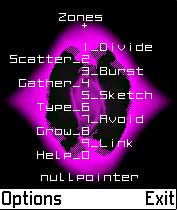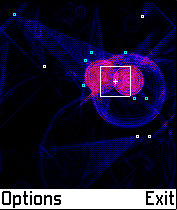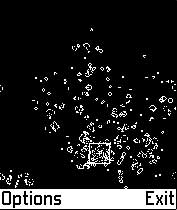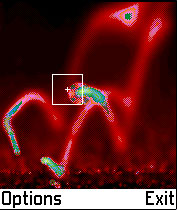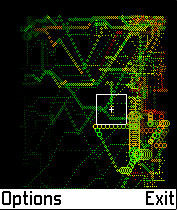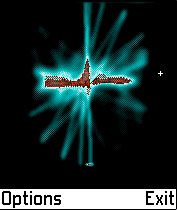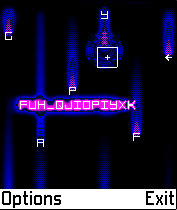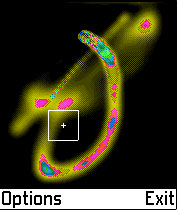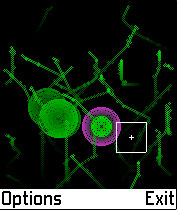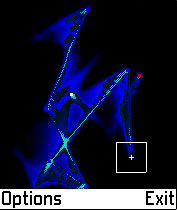 
|
||||||||||||||||||||
|
Plug-In :
An arts coucil technology residency
Introduction |
Research |
Project Stage 1 |
Project Stage 2 |
Project Stage 3 |
Results & Links
Project Stage 3
For the final program I created 10 different 'play' zones in one single application. Each zone would be accessible via a number key on the phone. Users can switch between zones at any time, allowing a 'bleed' effect where the residue from one zone would fade into another. The zero key triggers a small and cryptic help page, listing the zones by a single keyword that hints at the mode of interaction for that area.
The zones are discussed in more detail below. You can also download a zip file containing short movie clips (avi) of each zone.
This page offers one word descriptor hints as to what form of interaction is required in the subsequent zones. It also displays a 'demo-scene' style spirograph style dynamic form oscillating in the background.
In this zone small particles drift an bounce around the screen. If the users cursor touches a particle then it splits into several more. Particles eventually turn red and die. The user has to keep splitting the existing particles to increase the complexity of the scene. The field is processed using a fake 'water' effect allowing particles to generate wave-like trails across the surface. As the scene becomes more complex incidental 'raindrops' are added to the scene, further perturbing the visual surface.
This zone represents a classic implementation of Conways Life(cellular automata) algorithm.
This CA uses a very simple set of rules (If an occupied cell has two or three neighbors, the cell survives to the next generation. If an unoccupied cell has three occupied neighbors, it becomes occupied. Otherwise the cell is considered overcrowded or isolated and is removed). Even with such simple rules very complex behaviour can emerge from a chaotic system. The users cursor sprays random bacteria data across the surface, scattering potential CA lifeforms.
In this zone firework-like particles shoot from the base of the screen and arc back to the ground where they bounce back up again. If the users catches a particle in the cursor box then the firework explodes. After a certain number of explosions the number of fireworks is increased making the scene more complex. With more fireworks the zone also increases the incidence of random sparks and fire-like forms at the base of the screen. Eventually the zone become saturate with color and moving particles.
Trailing lines move around the screen, heading vaguely in the direction of the cursor. The longer they spend inside the cursor box the larger the trails become, also trigggering new trails to appear on the screen. The user can gather these trails from one part of the screen to another, changing their size and effect.
This zone acts like a semi-automatic spirograph. A looping geometric figure is sketched on the screen with the cursor position effecting the drawing parameters. This allows for a large range of forms to be generated.
Letters fall at different rates from the top of the screen, leaving trails behind them. If a letter is caught within the cursor box it is added to a word that is displayed in the center of the screen. Special characters such as delete and space allow the word to be edited further. If the word reaches 15 character in length it is wiped and the process starts again.
In this zone a particle chases the users cursor. If the users can avoid the particel for long enough it will grow in size and eventually produce another chasing particle. Collision with the cursor reduces the particle size. Long term successful avoiding will increase the number of pursuing objects to a large degree, also increasing the visual compexity of the scene with oversaturating trails.
Skinny plant-like growths move erratically up the screen. On entering the cursor box they split into two seperate sprouts and continue on different routes. Repeated splitting causes purple buds to appear at these junctions and evetually on the growing stalks themselves.
In this zone the User must link white particles together by collecting them one by one. If the user accidentally collects the red particle then the whole chain breaks and must be rebuilt. Each successful chain built adds another white particle to be connected to the next chain. As more links are needed the red particle speeds up and the scene becomes more complex.
|
||||||||||||||||||||
- buy SmartSound SonicFire Pro 5 Scoring
- buy cheap SmartSound SonicFire Pro 5 Scoring
- buy cheap SmartSound SonicFire Pro 5 Scoring software
- buy cheapest SmartSound SonicFire Pro 5 Scoring
- buy SmartSound SonicFire Pro 5 Scoring full version
- buy and download SmartSound SonicFire Pro 5 Scoring software
- SmartSound SonicFire Pro 5 Scoring program purchase
- buy SmartSound SonicFire Pro 5 Scoring online
- purchase order SmartSound SonicFire Pro 5 Scoring software
- buy used SmartSound SonicFire Pro 5 Scoring
- buy SmartSound SonicFire Pro 5 Scoring inexpensive
- buy SmartSound SonicFire Pro 5 Scoring price
- SmartSound SonicFire Pro 5 Scoring cheap download
- where to buy cheap Smith Micro Poser 7
- where can i buy Smith Micro Poser 7
- buy Smith Micro Poser 7
- buy cheap Smith Micro Poser 7
- buy cheap Smith Micro Poser 7 software
- buy cheapest Smith Micro Poser 7
- buy Smith Micro Poser 7 full version
- buy and download Smith Micro Poser 7 software
- Smith Micro Poser 7 program purchase
- buy Smith Micro Poser 7 online
- purchase order Smith Micro Poser 7 software
- buy used Smith Micro Poser 7
- buy Smith Micro Poser 7 inexpensive
- buy Smith Micro Poser 7 price
- Smith Micro Poser 7 cheap download
- where to buy cheap Sony ACID Pro 6
- where can i buy Sony ACID Pro 6
- buy Sony ACID Pro 6
- buy cheap Sony ACID Pro 6
- buy cheap Sony ACID Pro 6 software
- buy cheapest Sony ACID Pro 6
- buy Sony ACID Pro 6 full version
- buy and download Sony ACID Pro 6 software
- Sony ACID Pro 6 program purchase
- buy Sony ACID Pro 6 online
- purchase order Sony ACID Pro 6 software
- buy used Sony ACID Pro 6
- buy Sony ACID Pro 6 inexpensive
- buy Sony ACID Pro 6 price
- Sony ACID Pro 6 cheap download
- where to buy cheap Sony CD Architect 5.2
- where can i buy Sony CD Architect 5.2
- buy Sony CD Architect 5.2
- buy cheap Sony CD Architect 5.2
- buy cheap Sony CD Architect 5.2 software
- buy cheapest Sony CD Architect 5.2
- buy Sony CD Architect 5.2 full version
- buy and download Sony CD Architect 5.2 software
- Sony CD Architect 5.2 program purchase
- buy Sony CD Architect 5.2 online
- purchase order Sony CD Architect 5.2 software
- buy used Sony CD Architect 5.2
- buy Sony CD Architect 5.2 inexpensive
- buy Sony CD Architect 5.2 price
- Sony CD Architect 5.2 cheap download
- where to buy cheap Sony Sound Forge 9
- where can i buy Sony Sound Forge 9
- buy Sony Sound Forge 9
- buy cheap Sony Sound Forge 9
- buy cheap Sony Sound Forge 9 software
- buy cheapest Sony Sound Forge 9
- buy Sony Sound Forge 9 full version
- buy and download Sony Sound Forge 9 software
- Sony Sound Forge 9 program purchase
- buy Sony Sound Forge 9 online
- purchase order Sony Sound Forge 9 software
- buy used Sony Sound Forge 9
- buy Sony Sound Forge 9 inexpensive
- buy Sony Sound Forge 9 price
- Sony Sound Forge 9 cheap download
- where to buy cheap Sony Vegas Pro 8
- where can i buy Sony Vegas Pro 8
- buy Sony Vegas Pro 8
- buy cheap Sony Vegas Pro 8
- buy cheap Sony Vegas Pro 8 software
- buy cheapest Sony Vegas Pro 8
- buy Sony Vegas Pro 8 full version
- buy and download Sony Vegas Pro 8 software
- Sony Vegas Pro 8 program purchase
- buy Sony Vegas Pro 8 online
- purchase order Sony Vegas Pro 8 software
- buy used Sony Vegas Pro 8
- buy Sony Vegas Pro 8 inexpensive
- buy Sony Vegas Pro 8 price
- Sony Vegas Pro 8 cheap download
- where to buy cheap Sound Forge Audio Studio 9
- where can i buy Sound Forge Audio Studio 9
- buy Sound Forge Audio Studio 9
- buy cheap Sound Forge Audio Studio 9
- buy cheap Sound Forge Audio Studio 9 software
- buy cheapest Sound Forge Audio Studio 9
- buy Sound Forge Audio Studio 9 full version
- buy and download Sound Forge Audio Studio 9 software
- Sound Forge Audio Studio 9 program purchase
- buy Sound Forge Audio Studio 9 online
- purchase order Sound Forge Audio Studio 9 software
- buy used Sound Forge Audio Studio 9
- buy Sound Forge Audio Studio 9 inexpensive
- buy Sound Forge Audio Studio 9 price
- Sound Forge Audio Studio 9 cheap download
- where to buy cheap Steinberg Cubase 4.5
- where can i buy Steinberg Cubase 4.5
- buy Steinberg Cubase 4.5
- 4.5 Steinberg Cubase cheap buy
- buy cheap Steinberg Cubase 4.5 software
- buy cheapest Steinberg Cubase 4.5
- buy Steinberg Cubase 4.5 full version
- buy and download Steinberg Cubase 4.5 software
- 4.5 Steinberg Cubase purchase program
- buy Steinberg Cubase 4.5 online
- purchase order Steinberg Cubase 4.5 software
- Cubase buy Steinberg used 4.5
- buy Steinberg Cubase 4.5 inexpensive
- Cubase 4.5 buy price Steinberg
- Steinberg Cubase 4.5 cheap download
- where to buy cheap Steinberg Nuendo 3.2
- where can i buy Steinberg Nuendo 3.2
- buy Nuendo 3.2 Steinberg
- buy cheap Steinberg Nuendo 3.2
- buy cheap Steinberg Nuendo 3.2 software
- buy cheapest Steinberg Nuendo 3.2
- buy Steinberg Nuendo 3.2 full version
- buy and download Steinberg Nuendo 3.2 software
- Steinberg Nuendo 3.2 program purchase
- 3.2 Steinberg Nuendo buy online
- purchase order Steinberg Nuendo 3.2 software
- buy used Steinberg Nuendo 3.2
- buy Steinberg Nuendo 3.2 inexpensive
- buy Steinberg Nuendo 3.2 price
- Steinberg Nuendo 3.2 cheap download
- where to buy cheap Symantec Winfax Pro 10.4
- where can i buy Symantec Winfax Pro 10.4
- buy Symantec Winfax Pro 10.4
- buy cheap Symantec Winfax Pro 10.4
- buy cheap Symantec Winfax Pro 10.4 software
- buy cheapest Symantec Winfax Pro 10.4
- buy Symantec Winfax Pro 10.4 full version
- buy and download Symantec Winfax Pro 10.4 software
- Symantec Winfax Pro 10.4 program purchase
- buy Symantec Winfax Pro 10.4 online
- purchase order Symantec Winfax Pro 10.4 software
- buy used Symantec Winfax Pro 10.4
- buy Symantec Winfax Pro 10.4 inexpensive
- buy Symantec Winfax Pro 10.4 price
- Symantec Winfax Pro 10.4 cheap download
- where to buy cheap SystemsSuite Professional 8
- where can i buy SystemsSuite Professional 8
- buy SystemsSuite Professional 8
- SystemsSuite cheap 8 buy Professional
- buy cheap SystemsSuite Professional 8 software
- buy cheapest SystemsSuite Professional 8
- buy SystemsSuite Professional 8 full version
- buy and download SystemsSuite Professional 8 software
- SystemsSuite Professional 8 program purchase
- online buy Professional SystemsSuite 8
- purchase order SystemsSuite Professional 8 software
- buy Professional 8 used SystemsSuite
- buy SystemsSuite Professional 8 inexpensive
- buy SystemsSuite Professional 8 price
- SystemsSuite Professional 8 cheap download
- where to buy cheap TamoSoft CommView 6 Full
- where can i buy TamoSoft CommView 6 Full
- buy TamoSoft CommView 6 Full
- buy cheap TamoSoft CommView 6 Full
- buy cheap TamoSoft CommView 6 Full software
- buy cheapest TamoSoft CommView 6 Full
- buy TamoSoft CommView 6 Full full version
- buy and download TamoSoft CommView 6 Full software
- TamoSoft CommView 6 Full program purchase
- buy TamoSoft CommView 6 Full online
- purchase order TamoSoft CommView 6 Full software
- buy used TamoSoft CommView 6 Full
- buy TamoSoft CommView 6 Full inexpensive
- buy TamoSoft CommView 6 Full price
- TamoSoft CommView 6 Full cheap download
- where to buy cheap TamoSoft CommView For WiFi 6 Full
- where can i buy TamoSoft CommView For WiFi 6 Full
- buy TamoSoft CommView For WiFi 6 Full
- buy cheap TamoSoft CommView For WiFi 6 Full
- buy cheap TamoSoft CommView For WiFi 6 Full software
- buy cheapest TamoSoft CommView For WiFi 6 Full
- buy TamoSoft CommView For WiFi 6 Full full version
- buy and download TamoSoft CommView For WiFi 6 Full software
- TamoSoft CommView For WiFi 6 Full program purchase
- buy TamoSoft CommView For WiFi 6 Full online
- purchase order TamoSoft CommView For WiFi 6 Full software
- buy used TamoSoft CommView For WiFi 6 Full
- buy TamoSoft CommView For WiFi 6 Full inexpensive
- buy TamoSoft CommView For WiFi 6 Full price
- TamoSoft CommView For WiFi 6 Full cheap download
- where to buy cheap Thegrideon Access Password Professional 2.0
- where can i buy Thegrideon Access Password Professional 2.0
- buy Thegrideon Access Password Professional 2.0
- buy cheap Thegrideon Access Password Professional 2.0
- buy cheap Thegrideon Access Password Professional 2.0 software
- buy cheapest Thegrideon Access Password Professional 2.0
- buy Thegrideon Access Password Professional 2.0 full version
- buy and download Thegrideon Access Password Professional 2.0 software
- Thegrideon Access Password Professional 2.0 program purchase
- buy Thegrideon Access Password Professional 2.0 online
- purchase order Thegrideon Access Password Professional 2.0 software
- buy used Thegrideon Access Password Professional 2.0
- buy Thegrideon Access Password Professional 2.0 inexpensive
- buy Thegrideon Access Password Professional 2.0 price
- Thegrideon Access Password Professional 2.0 cheap download
- where to buy cheap TransMagic Expert
- where can i buy TransMagic Expert
- Expert buy TransMagic
- Expert cheap TransMagic buy
- buy cheap TransMagic Expert software
- buy cheapest TransMagic Expert
- buy TransMagic Expert full version
- buy and download TransMagic Expert software
- TransMagic Expert program purchase
- buy TransMagic Expert online
- purchase order TransMagic Expert software
- buy used TransMagic Expert
- buy TransMagic Expert inexpensive
- buy TransMagic Expert price
- TransMagic Expert cheap download
- where to buy cheap TuneUp Utilities 2008
- where can i buy TuneUp Utilities 2008
- buy TuneUp Utilities 2008
- buy cheap TuneUp Utilities 2008
- buy cheap TuneUp Utilities 2008 software
- buy cheapest TuneUp Utilities 2008
- buy TuneUp Utilities 2008 full version
- buy and download TuneUp Utilities 2008 software
- TuneUp Utilities 2008 program purchase
- Utilities online TuneUp 2008 buy
- purchase order TuneUp Utilities 2008 software
- buy used TuneUp Utilities 2008
- buy TuneUp Utilities 2008 inexpensive
- buy TuneUp Utilities 2008 price
- TuneUp Utilities 2008 cheap download
- where to buy cheap Uniblue RegistryBooster 2009
- where can i buy Uniblue RegistryBooster 2009
- buy Uniblue RegistryBooster 2009
- buy cheap Uniblue RegistryBooster 2009
- buy cheap Uniblue RegistryBooster 2009 software
- buy cheapest Uniblue RegistryBooster 2009
- buy Uniblue RegistryBooster 2009 full version
- buy and download Uniblue RegistryBooster 2009 software
- Uniblue RegistryBooster 2009 program purchase
- buy Uniblue RegistryBooster 2009 online
- purchase order Uniblue RegistryBooster 2009 software
- RegistryBooster 2009 used Uniblue buy
- buy Uniblue RegistryBooster 2009 inexpensive
- buy Uniblue RegistryBooster 2009 price
- Uniblue RegistryBooster 2009 cheap download
- where to buy cheap Uniblue SpeedUpMyPC 2009
- where can i buy Uniblue SpeedUpMyPC 2009
- buy Uniblue SpeedUpMyPC 2009
- Uniblue buy cheap 2009 SpeedUpMyPC
- buy cheap Uniblue SpeedUpMyPC 2009 software
- SpeedUpMyPC 2009 Uniblue buy cheapest
- buy Uniblue SpeedUpMyPC 2009 full version
- buy and download Uniblue SpeedUpMyPC 2009 software
- program Uniblue purchase SpeedUpMyPC 2009
- buy Uniblue SpeedUpMyPC 2009 online
- purchase order Uniblue SpeedUpMyPC 2009 software
- buy used Uniblue SpeedUpMyPC 2009
- buy 2009 Uniblue SpeedUpMyPC inexpensive
- buy Uniblue SpeedUpMyPC 2009 price
- Uniblue SpeedUpMyPC 2009 cheap download
- where to buy cheap VMware Workstation 6.5
- where can i buy VMware Workstation 6.5
- buy VMware Workstation 6.5
- buy cheap VMware Workstation 6.5
- buy cheap VMware Workstation 6.5 software
- buy cheapest VMware Workstation 6.5
- buy VMware Workstation 6.5 full version
- buy and download VMware Workstation 6.5 software
- VMware Workstation 6.5 program purchase
- buy VMware Workstation 6.5 online
- purchase order VMware Workstation 6.5 software
- buy used VMware Workstation 6.5
- buy VMware Workstation 6.5 inexpensive
- buy VMware Workstation 6.5 price
- VMware Workstation 6.5 cheap download
- where to buy cheap VMware Workstation 6.5 ACE
- where can i buy VMware Workstation 6.5 ACE
- buy Workstation 6.5 VMware ACE
- buy cheap VMware Workstation 6.5 ACE
- buy cheap VMware Workstation 6.5 ACE software
- buy cheapest VMware Workstation 6.5 ACE
- buy VMware Workstation 6.5 ACE full version
- buy and download VMware Workstation 6.5 ACE software
- VMware Workstation 6.5 ACE program purchase
- buy VMware Workstation 6.5 ACE online
- purchase order VMware Workstation 6.5 ACE software
- buy used VMware Workstation 6.5 ACE
- buy VMware Workstation 6.5 ACE inexpensive
- buy VMware Workstation 6.5 ACE price
- VMware Workstation 6.5 ACE cheap download
- where to buy cheap Web Page Maker 3
- where can i buy Web Page Maker 3
- buy Web Page Maker 3
- buy cheap Web Page Maker 3
- buy cheap Web Page Maker 3 software
- buy cheapest Web Page Maker 3
- buy Web Page Maker 3 full version
- buy and download Web Page Maker 3 software
- Web Page Maker 3 program purchase
- buy Web Page Maker 3 online
- purchase order Web Page Maker 3 software
- buy used Web Page Maker 3
- buy Web Page Maker 3 inexpensive
- buy Web Page Maker 3 price
- Web Page Maker 3 cheap download
- where to buy cheap Wincare Memory Booster Gold
- where can i buy Wincare Memory Booster Gold
- buy Wincare Memory Booster Gold
- buy cheap Wincare Memory Booster Gold
- buy cheap Wincare Memory Booster Gold software
- buy cheapest Wincare Memory Booster Gold
- buy Wincare Memory Booster Gold full version
- buy and download Wincare Memory Booster Gold software
- Wincare Memory Booster Gold program purchase
- buy Wincare Memory Booster Gold online
- purchase order Wincare Memory Booster Gold software
- buy used Wincare Memory Booster Gold
- buy Wincare Memory Booster Gold inexpensive
- buy Wincare Memory Booster Gold price
- Wincare Memory Booster Gold cheap download
- where to buy cheap Windows XP Professional SP3
- where can i buy Windows XP Professional SP3
- buy Windows XP Professional SP3
- buy cheap Windows XP Professional SP3
- buy cheap Windows XP Professional SP3 software
- buy cheapest Windows XP Professional SP3
- buy Windows XP Professional SP3 full version
- buy and download Windows XP Professional SP3 software
- Windows XP Professional SP3 program purchase
- buy Windows XP Professional SP3 online
- purchase order Windows XP Professional SP3 software
- buy used Windows XP Professional SP3
- buy Windows XP Professional SP3 inexpensive
- buy Windows XP Professional SP3 price
- Windows XP Professional SP3 cheap download
- where to buy cheap Xilisoft 1click DV to DVD
- where can i buy Xilisoft 1click DV to DVD
- buy Xilisoft 1click DV to DVD
- buy cheap Xilisoft 1click DV to DVD
- buy cheap Xilisoft 1click DV to DVD software
- buy cheapest Xilisoft 1click DV to DVD
- buy Xilisoft 1click DV to DVD full version
- buy and download Xilisoft 1click DV to DVD software
- Xilisoft 1click DV to DVD program purchase
- buy Xilisoft 1click DV to DVD online
- purchase order Xilisoft 1click DV to DVD software
- buy used Xilisoft 1click DV to DVD
- buy Xilisoft 1click DV to DVD inexpensive
- buy Xilisoft 1click DV to DVD price
- Xilisoft 1click DV to DVD cheap download
- where to buy cheap Xilisoft Audio Converter 2.1
- where can i buy Xilisoft Audio Converter 2.1
- buy Xilisoft Audio Converter 2.1
- buy cheap Xilisoft Audio Converter 2.1
- buy cheap Xilisoft Audio Converter 2.1 software
- buy cheapest Xilisoft Audio Converter 2.1
- buy Xilisoft Audio Converter 2.1 full version
- buy and download Xilisoft Audio Converter 2.1 software
- Xilisoft Audio Converter 2.1 program purchase
- buy Xilisoft Audio Converter 2.1 online
- purchase order Xilisoft Audio Converter 2.1 software
- buy used Xilisoft Audio Converter 2.1
- buy Xilisoft Audio Converter 2.1 inexpensive
- buy Xilisoft Audio Converter 2.1 price
- Xilisoft Audio Converter 2.1 cheap download
- where to buy cheap Xilisoft Audio Maker 3
- where can i buy Xilisoft Audio Maker 3
- buy Xilisoft Audio Maker 3
- buy cheap Xilisoft Audio Maker 3
- buy cheap Xilisoft Audio Maker 3 software
- buy cheapest Xilisoft Audio Maker 3
- buy Xilisoft Audio Maker 3 full version
- buy and download Xilisoft Audio Maker 3 software
- Xilisoft Audio Maker 3 program purchase
- buy Xilisoft Audio Maker 3 online
- purchase order Xilisoft Audio Maker 3 software
- buy used Xilisoft Audio Maker 3
- buy Xilisoft Audio Maker 3 inexpensive
- buy Xilisoft Audio Maker 3 price
- Xilisoft Audio Maker 3 cheap download
- where to buy cheap Xilisoft CD Ripper
- where can i buy Xilisoft CD Ripper
- buy Xilisoft CD Ripper
- buy cheap Xilisoft CD Ripper
- buy cheap Xilisoft CD Ripper software
- Xilisoft buy cheapest Ripper CD
- buy Xilisoft CD Ripper full version
- buy and download Xilisoft CD Ripper software
- Xilisoft CD Ripper program purchase
- buy Xilisoft CD online Ripper
- purchase order Xilisoft CD Ripper software
- buy used Xilisoft CD Ripper
- Ripper buy CD inexpensive Xilisoft
- Ripper price CD buy Xilisoft
- Xilisoft CD Ripper cheap download
- where to buy cheap Xilisoft DVD Ripper Platinum 5
- where can i buy Xilisoft DVD Ripper Platinum 5
- buy Xilisoft DVD Ripper Platinum 5
- buy cheap Xilisoft DVD Ripper Platinum 5
- buy cheap Xilisoft DVD Ripper Platinum 5 software
- buy cheapest Xilisoft DVD Ripper Platinum 5
- buy Xilisoft DVD Ripper Platinum 5 full version
- buy and download Xilisoft DVD Ripper Platinum 5 software
- Xilisoft DVD Ripper Platinum 5 program purchase
- buy Xilisoft DVD Ripper Platinum 5 online
- purchase order Xilisoft DVD Ripper Platinum 5 software
- buy used Xilisoft DVD Ripper Platinum 5
- buy Xilisoft DVD Ripper Platinum 5 inexpensive
- buy Xilisoft DVD Ripper Platinum 5 price
- Xilisoft DVD Ripper Platinum 5 cheap download
- where to buy cheap Xilisoft DVD Ripper Ultimate 5
- where can i buy Xilisoft DVD Ripper Ultimate 5
- buy Xilisoft DVD Ripper Ultimate 5
- buy cheap Xilisoft DVD Ripper Ultimate 5
- buy cheap Xilisoft DVD Ripper Ultimate 5 software
- buy cheapest Xilisoft DVD Ripper Ultimate 5
- buy Xilisoft DVD Ripper Ultimate 5 full version
- buy and download Xilisoft DVD Ripper Ultimate 5 software
- Xilisoft DVD Ripper Ultimate 5 program purchase
- buy Xilisoft DVD Ripper Ultimate 5 online
- purchase order Xilisoft DVD Ripper Ultimate 5 software
- buy used Xilisoft DVD Ripper Ultimate 5
- buy Xilisoft DVD Ripper Ultimate 5 inexpensive
- buy Xilisoft DVD Ripper Ultimate 5 price
- Xilisoft DVD Ripper Ultimate 5 cheap download
- where to buy cheap Xilisoft ISO Burner
- where can i buy Xilisoft ISO Burner
- ISO buy Burner Xilisoft
- buy cheap Xilisoft ISO Burner
- buy cheap Xilisoft ISO Burner software
- ISO buy Xilisoft cheapest Burner
- buy Xilisoft ISO Burner full version
- buy and download Xilisoft ISO Burner software
- Xilisoft ISO Burner program purchase
- buy Xilisoft ISO Burner online
- purchase order Xilisoft ISO Burner software
- used ISO Burner buy Xilisoft
- buy Xilisoft ISO Burner inexpensive
- buy Xilisoft ISO Burner price
- Xilisoft ISO Burner cheap download
- where to buy cheap Xilisoft Video Converter Ultimate 5.1
- where can i buy Xilisoft Video Converter Ultimate 5.1
- buy Xilisoft Video Converter Ultimate 5.1
- buy cheap Xilisoft Video Converter Ultimate 5.1
- buy cheap Xilisoft Video Converter Ultimate 5.1 software
- buy cheapest Xilisoft Video Converter Ultimate 5.1
- buy Xilisoft Video Converter Ultimate 5.1 full version
- buy and download Xilisoft Video Converter Ultimate 5.1 software
- Xilisoft Video Converter Ultimate 5.1 program purchase
- buy Xilisoft Video Converter Ultimate 5.1 online
- purchase order Xilisoft Video Converter Ultimate 5.1 software
- buy used Xilisoft Video Converter Ultimate 5.1
- buy Xilisoft Video Converter Ultimate 5.1 inexpensive
- buy Xilisoft Video Converter Ultimate 5.1 price
- Xilisoft Video Converter Ultimate 5.1 cheap download
- where to buy cheap Xilisoft Video To Audio Converter 5.1
- where can i buy Xilisoft Video To Audio Converter 5.1
- buy Xilisoft Video To Audio Converter 5.1
- buy cheap Xilisoft Video To Audio Converter 5.1
- buy cheap Xilisoft Video To Audio Converter 5.1 software
- buy cheapest Xilisoft Video To Audio Converter 5.1
- buy Xilisoft Video To Audio Converter 5.1 full version
- buy and download Xilisoft Video To Audio Converter 5.1 software
- Xilisoft Video To Audio Converter 5.1 program purchase
- buy Xilisoft Video To Audio Converter 5.1 online
- purchase order Xilisoft Video To Audio Converter 5.1 software
- buy used Xilisoft Video To Audio Converter 5.1
- buy Xilisoft Video To Audio Converter 5.1 inexpensive
- buy Xilisoft Video To Audio Converter 5.1 price
- Xilisoft Video To Audio Converter 5.1 cheap download
- where to buy cheap ZoneAlarm AntiVirus 8
- where can i buy ZoneAlarm AntiVirus 8
- 8 ZoneAlarm AntiVirus buy
- buy cheap ZoneAlarm AntiVirus 8
- buy cheap ZoneAlarm AntiVirus 8 software
- buy cheapest ZoneAlarm AntiVirus 8
- buy ZoneAlarm AntiVirus 8 full version
- buy and download ZoneAlarm AntiVirus 8 software
- ZoneAlarm AntiVirus 8 program purchase
- buy ZoneAlarm AntiVirus 8 online
- purchase order ZoneAlarm AntiVirus 8 software
- buy used ZoneAlarm AntiVirus 8
- buy ZoneAlarm AntiVirus 8 inexpensive
- buy ZoneAlarm AntiVirus 8 price
- ZoneAlarm AntiVirus 8 cheap download
- where to buy cheap ZoneAlarm Internet Security Suite 2009
- where can i buy ZoneAlarm Internet Security Suite 2009
- buy ZoneAlarm Internet Security Suite 2009
- buy cheap ZoneAlarm Internet Security Suite 2009
- buy cheap ZoneAlarm Internet Security Suite 2009 software
- buy cheapest ZoneAlarm Internet Security Suite 2009
- buy ZoneAlarm Internet Security Suite 2009 full version
- buy and download ZoneAlarm Internet Security Suite 2009 software
- ZoneAlarm Internet Security Suite 2009 program purchase
- buy ZoneAlarm Internet Security Suite 2009 online
- purchase order ZoneAlarm Internet Security Suite 2009 software
- buy used ZoneAlarm Internet Security Suite 2009
- buy ZoneAlarm Internet Security Suite 2009 inexpensive
- buy ZoneAlarm Internet Security Suite 2009 price
- ZoneAlarm Internet Security Suite 2009 cheap download
- where to buy cheap ZoneAlarm Internet Security Suite 8
- where can i buy ZoneAlarm Internet Security Suite 8
- buy ZoneAlarm Internet Security Suite 8
- buy cheap ZoneAlarm Internet Security Suite 8
- buy cheap ZoneAlarm Internet Security Suite 8 software
- buy cheapest ZoneAlarm Internet Security Suite 8
- buy ZoneAlarm Internet Security Suite 8 full version
- buy and download ZoneAlarm Internet Security Suite 8 software
- ZoneAlarm Internet Security Suite 8 program purchase
- buy ZoneAlarm Internet Security Suite 8 online
- purchase order ZoneAlarm Internet Security Suite 8 software
- buy used ZoneAlarm Internet Security Suite 8
- buy ZoneAlarm Internet Security Suite 8 inexpensive
- buy ZoneAlarm Internet Security Suite 8 price
- ZoneAlarm Internet Security Suite 8 cheap download
- where to buy cheap ZoneAlarm Pro 8
- where can i buy ZoneAlarm Pro 8
- buy ZoneAlarm Pro 8
- buy cheap ZoneAlarm Pro 8
- buy cheap ZoneAlarm Pro 8 software
- buy cheapest ZoneAlarm Pro 8
- buy ZoneAlarm Pro 8 full version
- buy and download ZoneAlarm Pro 8 software
- ZoneAlarm Pro 8 program purchase
- buy ZoneAlarm Pro 8 online
- purchase order ZoneAlarm Pro 8 software
- buy used ZoneAlarm Pro 8
- inexpensive 8 Pro ZoneAlarm buy
- buy ZoneAlarm Pro 8 price
- ZoneAlarm Pro 8 cheap download
